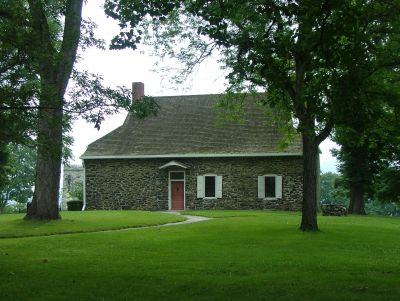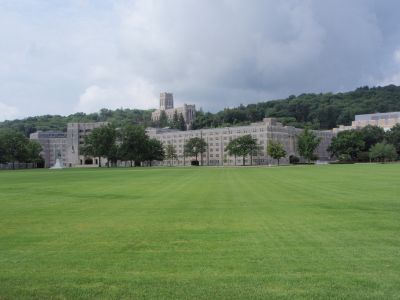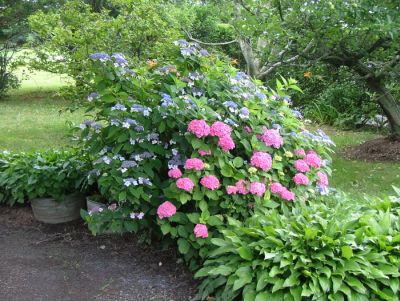West Point and Wine
 After
having spent the evening of the 4th of July in Newburgh, we were heading back to
Eva and Bill on Long Island. Before leaving town though, we wanted to
visit the house, that had been George Washingtons headquarter during a period
of The Recvolutionary War, actually from from 1780 to 1782. Our faithful Garmin
showed us the way without any problems, and we found the house, Hasbrouck House,
that is now serving as a museum. We parked in Liberty Street, the street
next to the museum, and crossed our fingers, that our luggage would still be
there, when we returned. When we got to the museum, we discovered, that it
hadn't opened yet. We therefore decided to settle for an outside look at the
premises. We walked around the grounds, and saw The Tower of Liberty, the grave
of Uzal Knapp, long lived veteran from The Continental Army, and I got a
picture of Dorte, next to a statue of a minuteman. Also we enjoyed the
views of Hudson River before returning to the car, and finding everything in
place.
After
having spent the evening of the 4th of July in Newburgh, we were heading back to
Eva and Bill on Long Island. Before leaving town though, we wanted to
visit the house, that had been George Washingtons headquarter during a period
of The Recvolutionary War, actually from from 1780 to 1782. Our faithful Garmin
showed us the way without any problems, and we found the house, Hasbrouck House,
that is now serving as a museum. We parked in Liberty Street, the street
next to the museum, and crossed our fingers, that our luggage would still be
there, when we returned. When we got to the museum, we discovered, that it
hadn't opened yet. We therefore decided to settle for an outside look at the
premises. We walked around the grounds, and saw The Tower of Liberty, the grave
of Uzal Knapp, long lived veteran from The Continental Army, and I got a
picture of Dorte, next to a statue of a minuteman. Also we enjoyed the
views of Hudson River before returning to the car, and finding everything in
place.
Our next stop was going to be The Military Academy at West Point, so I
programmed the Garmin once again. And once again it worked perfectly. Only I
didn't. I had to choose from several West Point addresses, and of course I
picked the wrong one. The GPS therefore lead us to the back entrance along the
river. The guards there told us where to go and eventually - after a few wrong
turns - we got to the main entrance. We parked the car, and entered the West
Point Museum.
We bought a ticket for the guided bus tour, and while we waited for that to commence, we walked around and saw parts of the museum including pictures of some of the Academy's bigwigs like Sylvanus Thayer, Dennis H. Mahan, Robert E. Lee ( btw Lee is, as far as I know, the only student to this day, that managed to complete his studies at West Point, without getting a single demerit), Ulysses S. Grant, Dwight D. Eisenhower and Douglas McArthur. We also read about Eisenhowers class of 1915, The Class that the Stars Fell Upon, with 59 out of a total of 164 cadets reaching rank of Brigadier or higher.
Next stop was the bus, and
after showing our passports, we climbed onboard along with a lot of other
visitors, and the bus took of. We enjoyed the tour and the stories told by the
guide, espcially the story of Douglas McArthur, whose mother lodged herself in a hotel outside
the academy for his whole stay there. From her hotelroom she could watch the room of
her little Douglas at the barracks, and if the light was turned out too late,
she blamed him for not getting anough sleep, and if it was turned off too early,
she criticized him for not studying hard enough. In spite of - or maybe
because of - the motherly control, McArthur finished first in both military and
theoretical subjets. We also got the explanation of why the third year students
were called cows, not "juniors" as in other colleges. First years students (freshmen)
at the academy are called plebes (from plebeian), as they are the lowest of the
low. Second year students (sophomores) are called "yearlings", because they have
been at the academy for a year. Third year students were called cows, because
after the first two years of study the cadets were allowed a furlough, and when
they returned from that, coming in flocks from the train station they "looked
like cows returning to the stable". Last year students are called "firsties" (from
"first class cadet"). Finally we were told about general Abner Doubleday,
who alledgedly invented baseball in his hometown, Cooperstown, during a furlough
from the academy in 1839. Unfortunately Doubleday never mentions anything of
baseball in diaries or letters, and as he started at the academy in 1838, he had
his first furlough in 1840, and therefor couldn't have invented anything in
Cooperstown in 1839 - but it's a nice story anyhow.
 The
bus made several stops, among others at the Cadets Chapel, the biggest of the
six church buildings on academy grounds, and home of the largest church organ
in the world, build by famous Danish organ builder Mathias Peter Møller. We saw
the barracks, the cemetery, with the graves of among others Winfield Scott,
John Buford, Robert Anderson, Daniel Butterfield, George Armstrong Custer,
Sylvanus Thayer and Daniel Mahan. And we were told the West Point Historical
Departments unofficial
motto: "Much of the history we teach was made by people we taught". Finally we
enjoyed the view of Hudson River from the actual West Point.
The
bus made several stops, among others at the Cadets Chapel, the biggest of the
six church buildings on academy grounds, and home of the largest church organ
in the world, build by famous Danish organ builder Mathias Peter Møller. We saw
the barracks, the cemetery, with the graves of among others Winfield Scott,
John Buford, Robert Anderson, Daniel Butterfield, George Armstrong Custer,
Sylvanus Thayer and Daniel Mahan. And we were told the West Point Historical
Departments unofficial
motto: "Much of the history we teach was made by people we taught". Finally we
enjoyed the view of Hudson River from the actual West Point.
After our visit to West Point we continued south along the Hudson on the Route 9W and later on Palisades Interstate Parkway. This lead us into New Jersey, were I discovered, that like in Oregon, you are not allowed to fill gas on your own car. After a short lunch break in New Jersey, we crossed the George Wasshington Bridge into the Bronx. Here we ended up in a traffic jam, but finally we got through and could take the I-678 south and across the Bronx Whitestone Bridge. We passed through Queens and from the interstate we saw the Billie Jean King Tennis Center in Flushing Meadows before turning east, and heading for Southold. Later we changed to I-495 East and continued to Riverhead. Here the traffic jammed again, and we discovered that some NASCAR race was taking place in town, but finally we got through and continued to Southold, were Eva had cooked dinner for us. Dannebrog, the Danish national flag, was still outside the house along with Starts and Stripes, and we had another nice visit with Eva and Bill. It should be the last time I met Eva as she passed away in early 2010. Dorte and her father managed one more visit in October 2008. We enjoyed the looks from the deck, and we once more visited their studios and admired their works; Eva's paintings and sculptures and Bill's wood carvings.
After our visit we drove to a hotel in Commack where we would spend the night.
The next day we were to return our rented car before going to New York City, but
we decided to go on a short tour of the Long Island Wine Country before going to
JFK. The day before, when we visisted Eva and Bill they told us how much Long
Island had changed, since they moved there. From potato growing country to wine
growing country. We, of course preferred the wine to the potatoes, so we looking
forward to this visit. Unfortunately it was a Sunday and quite a few of the
wineries we passed, were closed, and the first that was open was on the wrong
side of the road, where we could not cross. We finally found one that was open,
but it could only be visited by appointment, and we handn't made such. Instead,
we visited a mall and bought a cup of coffee. Then we agreed that if we did not
find an open winery in the next few miles, we would give up and go back to the
airpoirt.
 But
finally we had some luck, In the small town of Peconic Bay we passed Peconic Bay
Winery and it was open on Sundays. For $ 12 each we tasted 5 of their reserve
wines. Among these two different white wines, one of which was stored in oak,
and the second in steel tanks. Both were Chardonnay and both from 2005. Both
were produced from grapes from their own vineyard, so here we really had the
opportunity to taste, how much difference the maturing of the wine makes. The
three red wines were a 2001 Cabernet Sauvignon, a 2001 blend of Merlot /
Cabernet Sauvignon and a 2005 Cabernet Franc, and we ended up buying two of the
last, which we later brought home to Denmark. The girl, who was in charge of the
tasting, asked if we wanted to visit other wineries, and when we confirmed this,
she wrote the names of four other good places on a business card, while she drew
them onto a map. When we left the place we agreed that four places was too much,
so we decided to just visit two of the places she had designated.
But
finally we had some luck, In the small town of Peconic Bay we passed Peconic Bay
Winery and it was open on Sundays. For $ 12 each we tasted 5 of their reserve
wines. Among these two different white wines, one of which was stored in oak,
and the second in steel tanks. Both were Chardonnay and both from 2005. Both
were produced from grapes from their own vineyard, so here we really had the
opportunity to taste, how much difference the maturing of the wine makes. The
three red wines were a 2001 Cabernet Sauvignon, a 2001 blend of Merlot /
Cabernet Sauvignon and a 2005 Cabernet Franc, and we ended up buying two of the
last, which we later brought home to Denmark. The girl, who was in charge of the
tasting, asked if we wanted to visit other wineries, and when we confirmed this,
she wrote the names of four other good places on a business card, while she drew
them onto a map. When we left the place we agreed that four places was too much,
so we decided to just visit two of the places she had designated.
The next place we visited was a little further out on the island but still in
the town of Peconic. Here there were some very nice hydrangeas outside and we
just had to look at them before entering the tasting room. Once again you could
choose between two tastings, one with wine from young vines, and one with "old
vine wines". We chose the latter, and we should
probably not have done that, since the wines we got to taste was excellent. One of them,
a 2001 merlot was probably the best wine I ha ve tasted in the U.S. (including
California) and perhaps in general, their 2001 Merlot. Unfortunately we couldn't
buy any, as it was sold exclusively to wine club members. They offered us
membership of the club, but the distance between Copenhagen, Denmark and Peconic,
USA was a bit to far for us to join :-).
The next place on the list that should have been our last visit , proved to be
closed in spite of the information we had gotten the first place, so we
continued
to Jamesport Vineyards. Here we tasted 6 different reds of varying quality, and
ended up buying four bottles of Cabernet Franc. One bottle we drank later in New
York City, but we actually managed to get three bottles back to Denmark. From
Jamesport we returned to JFK, returned our car and took a limo service to our
prebooked hotel in Manhattan.
- Return to New
Enlgand and New York -
- Return to Travel Stories -